Brazil
Enchanting Traditions and Natural Wonders
South America unfolds as a vibrant tapestry, where cultural riches intertwine with breathtaking landscapes. Peru's legendary Machu Picchu enchants, whispering stories of the Inca Empire's ingenuity. Immerse yourself in the colonial heritage of Cusco's charming streets and the fortified walls of Cartagena in Colombia. Feel the thunderous cascades of Iguazu Falls, a natural wonder that will leave you in awe of nature's majesty. In Buenos Aires, sultry tango rhythms and vibrant street art promise a cultural extravaganza tailored to your discerning taste. Note, when booking your South America vacation, remember the seasons in the Earth's southern hemisphere are reversed.
Brazil
Amazon Rainforest, Brazil:
 Photo by Lucas / Adobe Stock Photo by Lucas / Adobe Stock | A journey into the Amazon Rainforest promises retirees a true immersion into the heart of nature. Witness the incredible biodiversity, vibrant wildlife, and captivating indigenous cultures. A guided jungle expedition will offer the chance to spot toucans, monkeys, and elusive jaguars. Another great way to experiennce the Amazon is to embark on a either an eco-friendly cruise. |
Eco-cruises typically focus on providing guests with an educational and immersive experience of the Amazon rainforest and typically include opportunities to go hiking, wildlife watching, and learning about the rainforest's plants and animals. Eco-tours typically don't have air-conditioning, but they do usually provide swamp coolers in cabins which are effective and less hamrful to the environment. If you want to splurge, why not treat yourself to a luxury cruise to experience the Amazon in comfort and style. These cruises typically feature spacious cabins, gourmet dining, air-conditioning and a variety of onboard activities.
Best Time to Visit:
The Amazon Rainforest has two distinct seasons, wet and dry, both of which offer unique advantages. The dry season provides better wildlife sightings and drier conditions, while the wet season showcases the rainforest's dynamic ecosystem in full display.
Dry Season (June to November):
Average Temperature: 70°F to 90°F (21°C to 32°C)
This period offers drier weather, making it easier to explore the rainforest and spot wildlife. The lower humidity enhances comfort during outdoor activities. Considered the prime time for many travelers.
Wet Season (December to May):
Average Temperature: 75°F to 95°F (24°C to 35°C)
This season brings more rainfall and higher river levels. The rainforest is lush and vibrant during this time, and you can experience the full bloom of vegetation. Birdwatching and unique aquatic experiences are highlights.
|
Rio de Janeiro, Brazil:
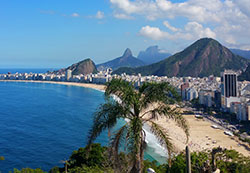 Photo by Gustavo / Adobe Stock Photo by Gustavo / Adobe Stock | Rio de Janeiro, with its iconic Christ the Redeemer statue and golden beaches, is a city that pulsates with energy. Take a leisurely stroll along the famous Copacabana Beach, and enjoy the refreshing ocean breeze. For breathtaking panoramic views, a take a thrilling cable car ride up to Sugarloaf Mountain and delight in the city's stunning skyline against the backdrop of the Atlantic Ocean.
|
Immerse yourself in the city's rich cultural scene by joining a samba dance class, and learn the infectious rhythm of Brazil's signature dance and embrace the lively local spirit. To delve deeper into Rio's heritage, taking a guided cultural tour through historic neighborhoods like Santa Teresa provides insights into the city's artistic roots and diverse architecture.
Best Time to Visit:
Dry Season (May to September):
Temperature range: 65°F - 75°F (18°C - 24°C)
This is generally considered the best time to visit Rio de Janeiro due to the clear skies and minimal rainfall. The weather is cooler, especially in the evenings, so make sure to pack some warm layers.
Shoulder Seasons (April and October):
Temperature range: 65°F - 80°F (18°C - 27°C)
These months can be a good compromise between the dry season and the rainy season. You might experience fewer crowds compared to the peak dry season, and the weather can still be pleasant but with moderate rainfall.
Rainy Season (November to March):
Temperature range: 65°F - 85°F (18°C - 29°C)
This period sees more rainfall, and there's a higher chance of cloudy and misty conditions. The advantage of visiting during this time is that you might encounter fewer tourists, but the weather can be unpredictable and outdoor activities might be affected.
|
Salvador, Brazil:
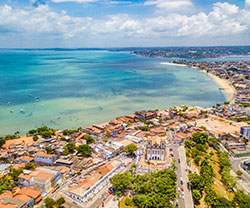
Photo by Estebran / Adobe Stock |
Salvador, was founded in 1549 by the Portuguese and was the capital of Brazil until 1763, and today is the capital of the state of Bahia. It offers spanish colonial charm and colorful streets filled with music, dance, and delicious cuisine. Explore Pelourinho, a historic district in Salvidor that was onnce a center for the slave trade. Today it is now a UNESCO World Heritage site and a living museum of Afro-Brazilian culture.
|
You can find capoeira schools, samba bars, and traditional restaurants in the district. Participate in a Capoeira workshop to learn the martial art infused with dance and music, or attend a traditional Candomblé ceremony to experience the spiritual side of Brazil. Beach lovers will enjoy exploring the beaches of Itapuã and Porto da Barra.
Best Time to Visit:
Dry Season (November to March):
Temperature: 75°F - 90°F (24°C - 32°C)
This period is considered the dry season, characterized by lower rainfall and warm temperatures. It's a popular time for visitors due to the pleasant weather, making it great for exploring the city and its attractions.
Rainy Season (April to October):
Temperature: 70°F - 85°F (21°C - 29°C)
The rainy season brings more frequent rainfall, although the temperatures remain relatively warm. While this might not be the most popular time for tourists due to the rain, it's a good opportunity to experience the local culture and events.
|
Brazil's allure lies in its diverse landscapes, rich history, and warm hospitality. Retirees who venture to these top destinations can expect a memorable journey filled with cultural enrichment, natural wonders, and unforgettable memories.
Travel Planning Tips:
Best Time to Visit: The best time to visit South America varies by region and activity. For travelers over 50, consider the dry season, which typically falls between May and September. This is an ideal time for outdoor exploration, sightseeing, and cultural experiences. However, keep in mind that the southern hemisphere's seasons are opposite to those in the northern hemisphere.
Transportation:
Buses:Buses are the most popular way to get around Brazil. There are numerous bus companies operating throughout the country, offering a wide range of services and prices. Brazilian buses are generally comfortable and reliable, making them an excellent way to explore the country's diverse regions.
Domestic flights: Domestic flights are a convenient mode of travel between major cities in Brazil due to the country's vast size. Several airlines operate domestic flights, such as LATAM Airlines, Azul Linhas Aéreas, and Gol Linhas Aéreas. These flights are often affordable and can significantly reduce travel time when covering long distances within the country.
Trains: While Brazil's train network is not as extensive as in some countries, it offers some unique and scenic routes. One notable train journey is the "Serra Verde Express" that runs between Curitiba and Morretes, providing stunning views of the Atlantic Rainforest and lush landscapes.
Car rentals: Car rentals are readily available in major cities throughout Brazil. Renting a car can be a great option for exploring both urban and remote areas at your own pace. However, it's essential to be cautious while driving, as road conditions can vary, and traffic in some cities can be challenging to navigate.
Health and Safety Tips:
- Exercise caution regarding your personal belongings to prevent theft, especially in crowded tourist areas.
- Avoid wearing expensive jewelry or displaying valuable items to minimize the risk of attracting unwanted attention.
- When crossing streets, be vigilant as traffic regulations might not be strictly enforced.
- Opt for bottled water to stay hydrated and avoid consuming tap water, which may not be safe.
- Take precautions against mosquito-borne illnesses such as malaria and dengue fever. Use insect repellent and wear protective clothing to reduce the risk.
- Choose reputable transportation services or arrange transfers in advance, particularly when arriving at or departing from airports.
- Stay informed about the safety conditions in the regions you plan to visit and follow advice from local authorities.
- Respect visa regulations and adhere to permitted stay durations to avoid legal complications.
Travel Visa Requirements
It is crucial to adhere to immigration regulations and visa requirements while traveling in South America to ensure a smooth and hassle-free journey. Overstaying your visa can lead to serious consequences in some countries. Here are some tips to help you avoid any issues related to overstaying your visa:
- Know Your Visa Requirements: Before traveling to South America, thoroughly research the visa requirements for the specific countries you plan to visit. Each country has its own rules regarding entry, duration of stay, and visa extensions. Familiarize yourself with the visa regulations and ensure that you meet the necessary criteria.
- Check Visa Validity Period: Carefully review the validity period of your visa and make sure you understand the maximum duration of stay allowed. Some visas may have specific conditions or restrictions, such as a limit on the number of days or requirements for visa extensions. Be mindful of these details to avoid overstaying.
- Plan Your Itinerary: Plan your itinerary in advance and make sure it aligns with the duration of your visa. Consider the time you intend to spend in each country and calculate the number of days you will be staying. Allow for some buffer time to account for unexpected delays or changes in your travel plans.
- Monitor Your Visa Expiry Date: Stay vigilant about the expiration date of your visa. Mark it on your calendar or set reminders to ensure you are aware of when your visa is due to expire. Avoid leaving it until the last minute to address any necessary visa extensions or depart the country within the permitted timeframe.
- Seek Visa Extensions, if Needed: If you find yourself in a situation where you need to extend your visa due to unforeseen circumstances or changes in travel plans, contact the local immigration authorities or embassy of the respective country. Follow the proper procedures for visa extension and submit the required documentation within the designated timeframe.
- Consult with Local Authorities: If you have any doubts or questions regarding your visa status or duration of stay, seek assistance from local immigration authorities or reputable legal professionals. They can provide accurate information, guidance, and support to help you navigate the visa regulations effectively.
- Respect Local Laws and Customs: While traveling, it is essential to respect the local laws, customs, and regulations of the countries you visit. Engaging in any illegal activities or violating visa rules can have severe consequences. Stay informed about the local laws and abide by them to ensure a safe and enjoyable journey.
- Travel Advisories Stay updated on current events, local regulations, and any travel advisories when traveling abroad. Visit the US Government State Department Travel Advisories web site to check on the status of your destination.
- Enroll in the STEP Program: Travelers are also urged to enroll in the U.S. State Department's Smart Traveler Enrollment Program (STEP) to receive security messages and to make it easier to locate them in an emergency. The Department uses these security messages to convey information about terrorist threats, security incidents, planned demonstrations, natural disasters, etc. In an emergency, please contact the nearest U.S. Embassy or consulate or call the following numbers: 1 (888) 407-4747 (toll-free in the United States and Canada) or 1 (202) 501-4444 from other countries.
Remember, visa regulations and enforcement can vary from country to country. It is your responsibility as a traveler to comply with the immigration laws of the countries you visit. By being knowledgeable, proactive, and respectful of visa requirements, you can avoid any issues related to overstaying your visa and ensure a positive travel experience throughout South America.
| |
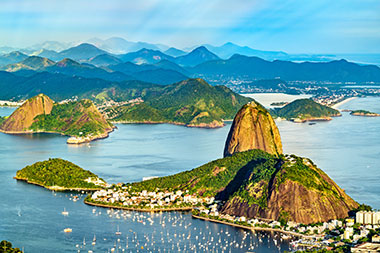 Photo by Leonid Andronov / Adobe Stock
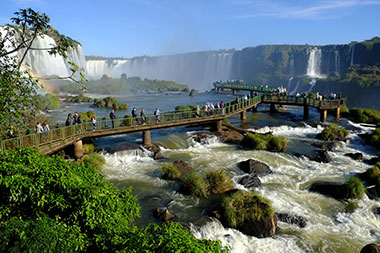 Iguazu Falls Photo by Marko / Adobe Stock
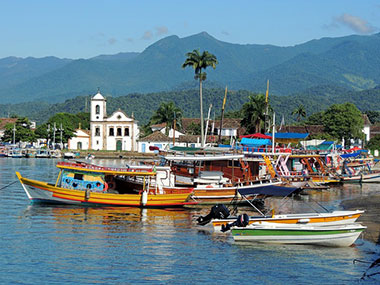 Photo by Clara TCHOUBÉ / Pixabay
|
 Photo by Leonid Andronov / Adobe Stock
Photo by Leonid Andronov / Adobe Stock  Iguazu Falls
Iguazu Falls  Photo by Clara TCHOUBÉ / Pixabay
Photo by Clara TCHOUBÉ / Pixabay